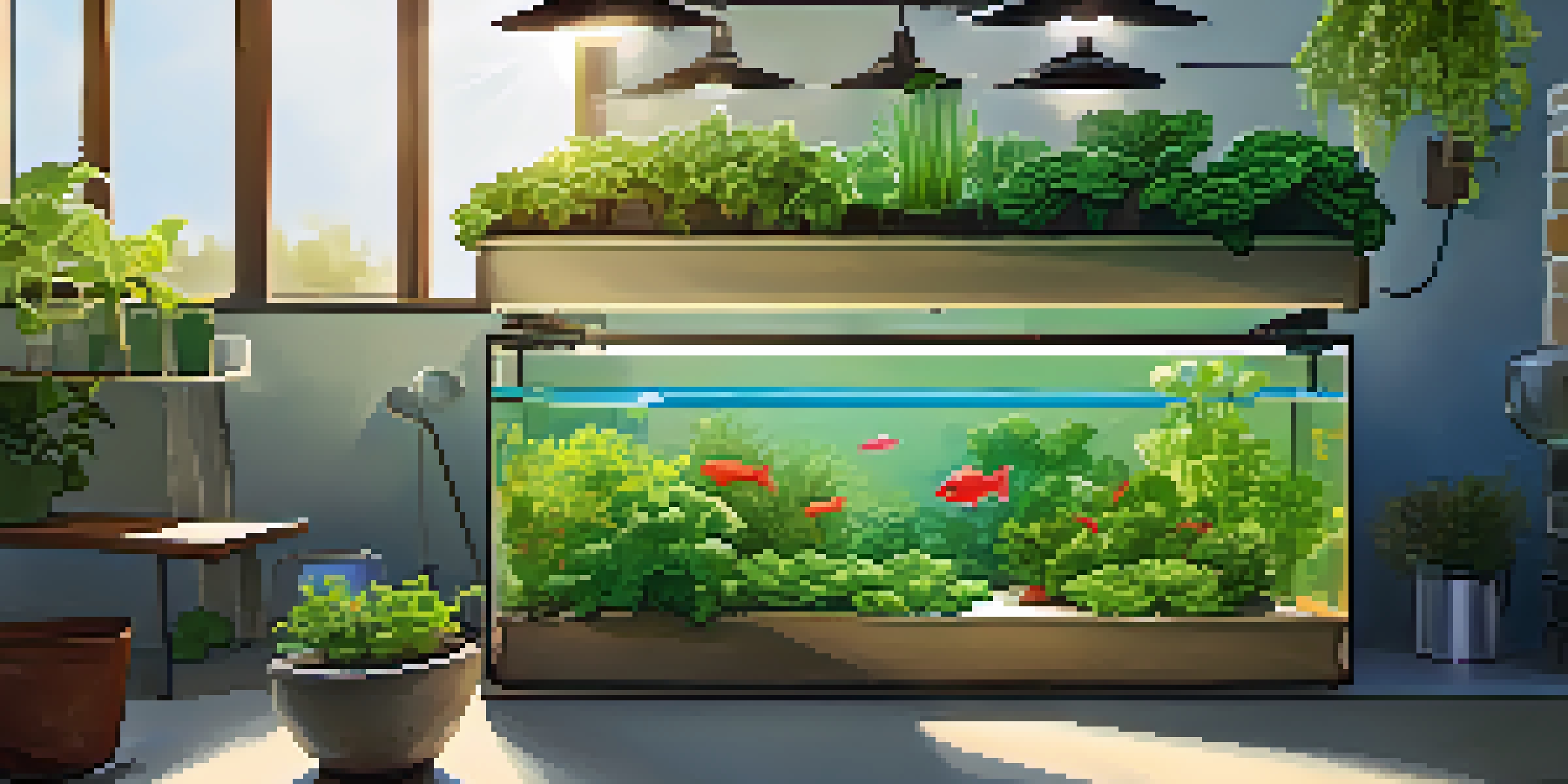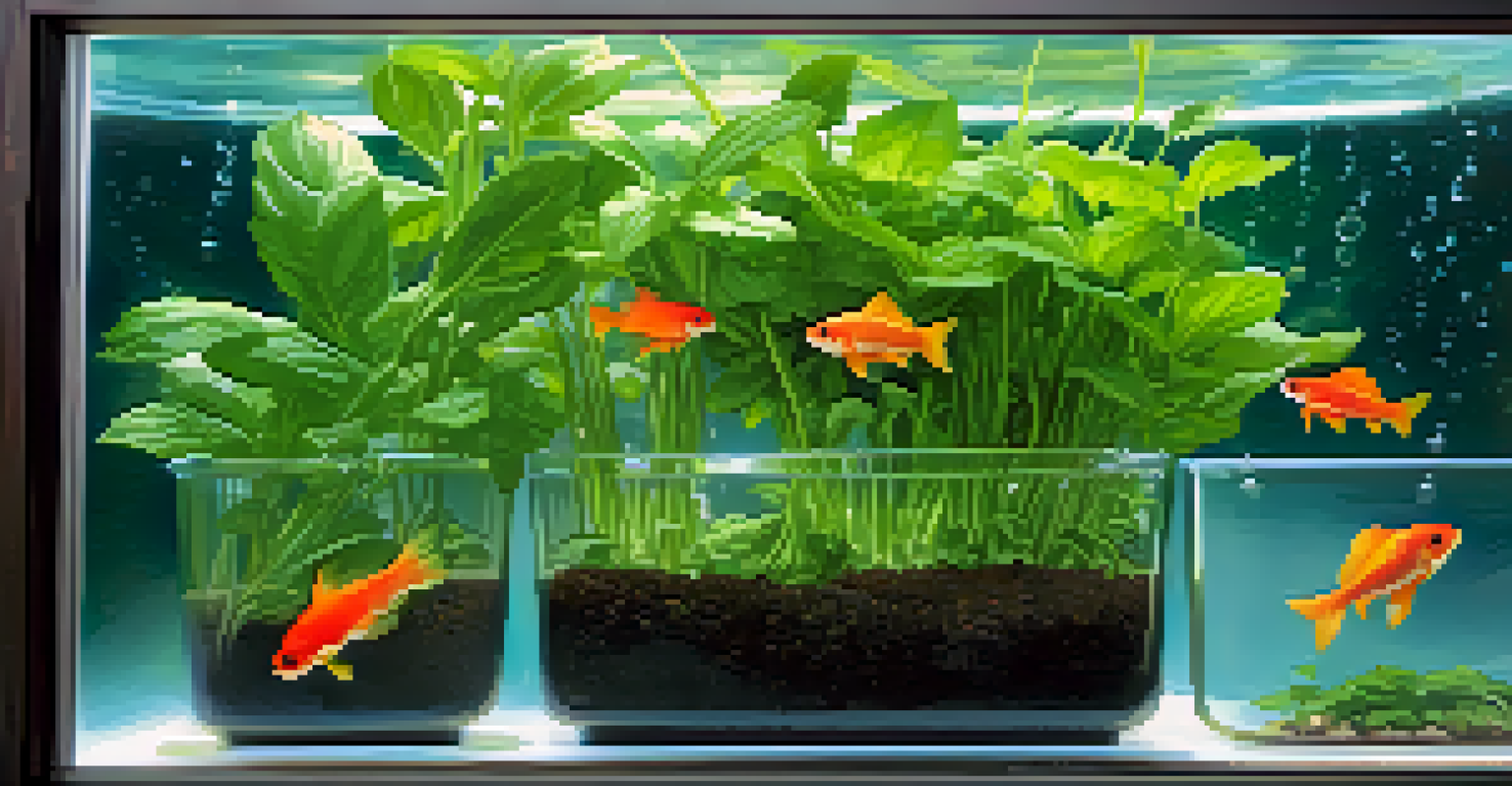Aquaponics Plants: Best Varieties for Sustainable Growth

Understanding Aquaponics: A Brief Overview
Aquaponics is a sustainable farming system that combines aquaculture and hydroponics. In simple terms, it allows you to grow plants and fish together in a symbiotic environment. The fish waste provides nutrients for the plants, while the plants help to filter and clean the water for the fish. This closed-loop system is not only efficient but also minimizes the need for chemical fertilizers.
In nature, nothing exists alone.
Imagine a mini-ecosystem right in your backyard, where fish and plants support each other. This method not only conserves water but also reduces the carbon footprint associated with traditional farming. It’s like having your cake and eating it too—growing fresh produce while raising fish in a way that benefits both.
For those looking to start their own aquaponics garden, understanding which plants thrive in this unique environment is crucial. The right choices can lead to a flourishing setup that yields healthy food year-round, making aquaponics a rewarding venture for both hobbyists and serious gardeners.
Top Leafy Greens for Aquaponics Success
Leafy greens are some of the best plants for aquaponics, and for good reason. Varieties like lettuce, kale, and spinach grow quickly and thrive in nutrient-rich water. They also have a relatively short growing cycle, meaning you can enjoy the fruits of your labor in no time. Plus, their high demand in the market makes them a smart choice for aspiring aquaponics farmers.

These greens are not only easy to grow, but they also help maintain a balanced ecosystem in your aquaponics system. For instance, lettuce can absorb excess nitrogen produced by fish waste, which keeps the water clean and the fish happy. It’s a win-win situation that encourages sustainable growth and healthy yield.
Aquaponics: A Sustainable Farming Method
Aquaponics combines fish farming and plant cultivation in a closed-loop system, promoting resource efficiency and minimizing environmental impact.
Starting with leafy greens can also help you gain confidence in your aquaponics skills. As you see your first crops flourish, you’ll be inspired to expand your garden and experiment with other plant varieties, leading to a more diverse and productive aquaponics setup.
Herbs That Thrive in Aquaponic Systems
Herbs are another fantastic option for aquaponics gardens, adding both flavor and value to your dishes. Varieties like basil, mint, and cilantro are particularly well-suited for aquaponic systems. They are typically fast-growing and require minimal space, making them perfect for small-scale setups or home gardens.
Sustainability is no longer about doing less harm. It's about doing more good.
Growing herbs in aquaponics not only enhances your culinary creations but also provides a natural pest deterrent. For instance, basil can repel certain insects while attracting pollinators, creating a balanced environment. This means less reliance on chemical pesticides, which is a big plus for sustainability.
Moreover, herbs can be harvested continuously, allowing for a steady supply of fresh ingredients. This not only promotes a healthier diet but can also be a lucrative addition to your aquaponics venture, especially if you decide to sell your produce at local markets.
Fruit-Bearing Plants for Aquaponics Gardens
If you’re looking to add some sweetness to your aquaponics setup, consider fruit-bearing plants like strawberries and tomatoes. These plants not only provide delicious rewards but can also thrive in an aquaponic environment when given the proper care. They generally require a bit more attention than leafy greens or herbs, but the payoff is well worth the effort.
Strawberries, for example, can adapt well to the nutrient-rich water while providing vibrant colors and flavors. They also tend to attract pollinators, which can help enhance your overall garden ecosystem. Knowing that you can grow your own fresh strawberries can add a delightful touch to your meals and desserts.
Ideal Plants for Aquaponics Success
Leafy greens, herbs, and fruit-bearing plants are excellent choices for aquaponics, as they thrive in nutrient-rich water and contribute to a balanced ecosystem.
Tomatoes, on the other hand, can be a bit more challenging but are incredibly rewarding. They require adequate light and slightly warmer conditions, but with the right setup, you can enjoy a bountiful harvest. Whether you’re slicing them for a salad or making a homemade sauce, homegrown tomatoes elevate any dish.
Choosing the Right Fish for Your Aquaponics System
Just as important as selecting the right plants is choosing the right fish for your aquaponics system. Fish like tilapia, catfish, and goldfish are popular choices because they thrive in a range of conditions and produce a significant amount of waste, which is essential for feeding your plants. Each type of fish has its unique requirements, so it’s important to do your research.
Tilapia, for instance, are favored for their fast growth and hardiness. They can tolerate varying water conditions and are relatively easy to care for. Plus, their mild flavor makes them a favorite in many kitchens, providing an additional incentive for aquaponics enthusiasts.
On the other hand, catfish are a bottom feeder, which can help keep the system clean by consuming leftover food and organic matter. Goldfish, while not typically used for eating, add a vibrant pop of color to your system and are an excellent choice for beginners. Selecting the right fish can enhance your aquaponics experience and lead to a more successful garden.
Best Practices for Aquaponics Plant Care
Caring for your aquaponics plants is vital to ensure a thriving ecosystem. Regular monitoring of water quality is essential, as plants and fish both depend on it for their health. Maintaining the right pH levels and nutrient balance can prevent common issues and promote healthy growth. Remember, a healthy environment leads to a flourishing garden.
Another important practice is to ensure adequate light for your plants. Most plants will thrive with 12 to 16 hours of light each day, whether from natural sunlight or grow lights. Adjusting the light based on your plant varieties will help them flourish and produce the best yields.
Choosing the Right Fish Matters
Selecting appropriate fish like tilapia or catfish is crucial for enhancing the aquaponic system, as they provide essential nutrients for plant growth.
Lastly, be mindful of plant spacing and airflow. Overcrowding can lead to poor growth and increased susceptibility to pests and diseases. By giving your plants room to breathe and grow, you’re setting the stage for a successful aquaponics garden that can thrive sustainably.
The Future of Aquaponics and Sustainable Farming
As we move towards a more sustainable future, aquaponics presents an innovative solution to food production challenges. With its efficient use of resources, it can provide fresh produce and protein in urban areas where traditional farming may not be feasible. This method not only reduces the environmental impact but also promotes local food systems, making it a win for everyone.
The growing interest in aquaponics is leading to more research and advancements in techniques, making it accessible to a wider audience. Schools, community gardens, and even commercial farms are adopting this method, showcasing its potential to revolutionize the way we think about food production. Imagine cities filled with vertical farms, producing fresh food right where it's needed most.

In conclusion, aquaponics is not just a trend—it’s a viable solution for sustainable growth. By choosing the right plants, caring for them properly, and understanding the symbiotic relationships within your system, you can contribute to a healthier planet while enjoying the benefits of homegrown food. The future of farming is bright, and aquaponics is leading the way.